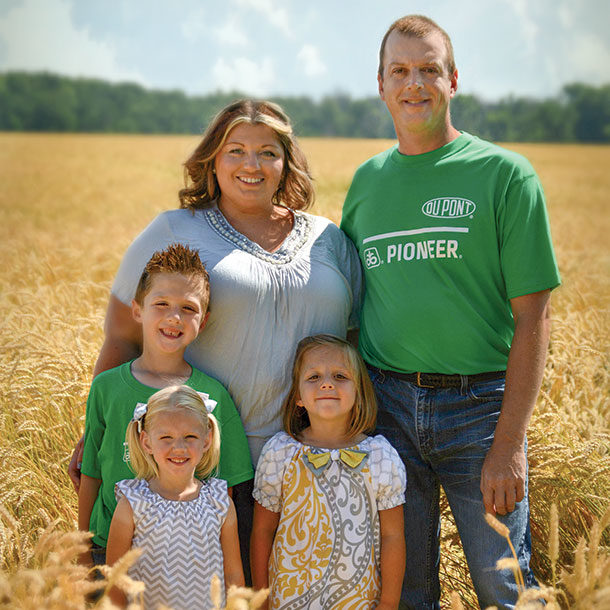Some of these stories you may have seen in print this past year, while others appeared only in our Extra newsletters. If you’re not on the list to receive our Extra newsletter, sign up online Progressive Forage.
And new in 2017, if you’d like to receive instant notification anytime a new hay market report is available, you can sign up for that online (Progressive Forage Hay Market Reports).
1. Two-bucket farm wife: Lisa Szymanski
Published April 2016
Progressive Forage Editor Lynn Jaynes
Readers enjoyed meeting Lisa Szymanski, a two-bucket farm wife from Port Austin, Michigan. What’s a two-bucket gal?
A two-bucket gal is a woman who can do two or more things at once: help on the farm, no matter what the job; wash the family’s greasy clothes; have lunches ready; run the tractor, planter or whatever needs running; manage the house; and be the glue of the family. In Lisa’s case, a lot of glue is needed.
Lisa is the mother of three, farm bookkeeper for a farm of 1,200 acres where they also have a seed processing and seed selling business. She runs equipment like a pro – well, except for that one time …. Nevertheless, her husband Frank says, “I’ve married a winner … Actually, I’m the winner. I get her.”
Read her story: Two-bucket farm wife: Lisa Szymanski.
2. Froese Brothers’ custom silage business increases efficiency with the golden rule
Published May 2016
Progressive Forage Editor Cassidy Woolsey
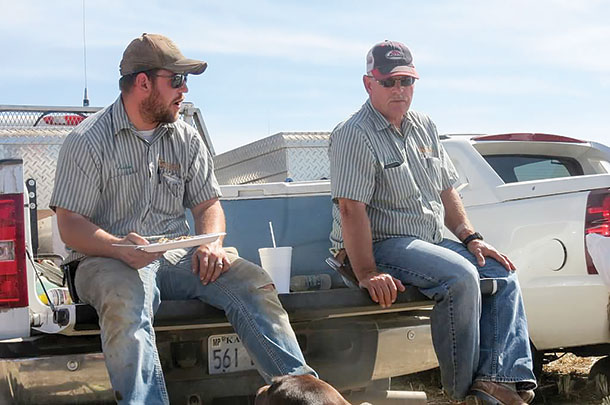 For the past 60 years, the Froese family business – now owned by Ray Froese and his two sons, Beau and Austin – have custom-harvested grain and silage for producers, cattle feeders and dairymen across the Midwest.
For the past 60 years, the Froese family business – now owned by Ray Froese and his two sons, Beau and Austin – have custom-harvested grain and silage for producers, cattle feeders and dairymen across the Midwest.
In this popular article, readers enjoyed a peek into this Kansas family’s routine and their “treat others the way you would like to be treated” mindset that has essentially made them notable in the industry.
They understand that with this business, time is precious; any delay could affect their reputation and, most importantly, the customer’s chop quality.
As Ray Froese points out, “It’s a business that, when it’s time to harvest, the goal is to get it out of the field as quickly as possible” – something the Froeses strive hard to maintain.
Learn more about their custom business: Froese Brothers' custom silage business increases effciency with the golden rule.
3. Two-bucket farm wife: Velma Riddle
Published June 2016
Progressive Forage Editor Cassidy Woolsey
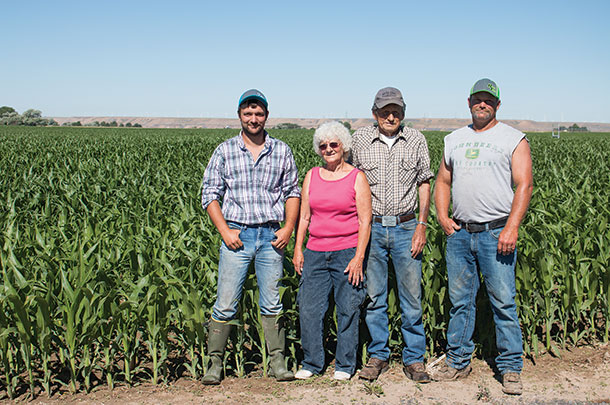 Don’t let Velma Riddle’s white hair fool you. This 73-year-old farm gal from Tuttle, Idaho, can disk, cultivate, chisel plow, roller harrow, spray, run the grain cart or whatever else needs running – just as well as anyone half her age.
Don’t let Velma Riddle’s white hair fool you. This 73-year-old farm gal from Tuttle, Idaho, can disk, cultivate, chisel plow, roller harrow, spray, run the grain cart or whatever else needs running – just as well as anyone half her age.
Her husband, Len, describes her best: “She does everything, and what she doesn’t do, she could do … I don’t know what all of us would do without her.”
Stepping back into the last half of the 1900s, readers were captivated as Len walked them through their first years on the farm and reminded them what farming is really about: hard work, family and most of all – passion for something greater than yourself.
Read her story: Two-bucket farm wife: Velma Riddle.
4. Mississippi rancher uses homemade bale unroller
Published February 2016
Progressive Forage Writer Carrie Veselka
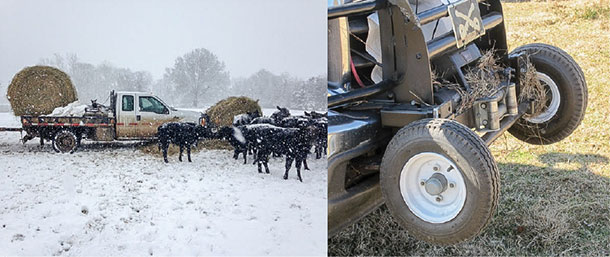 Readers always appreciate hearing about the ingenuity of others. In this article, Mississippi rancher Andy Anderson has developed a cheaper, simpler way to feed out round bales that enables him to feed his 400-head herd with very little trouble.
Readers always appreciate hearing about the ingenuity of others. In this article, Mississippi rancher Andy Anderson has developed a cheaper, simpler way to feed out round bales that enables him to feed his 400-head herd with very little trouble.
He took the axle from an old boat trailer, the tow bar from a receiving hitch and a few lengths of metal tubing and welded them together, making a lightweight bale unroller that can easily attach to the front of his feed pickup.
Besides being efficient and easy to attach, the homemade unroller works with any size and density of bale and, according to Anderson, stretches the hay farther.
In Anderson’s opinion, it would be a simple affair for anyone to make a bale unroller from scratch. “You can buy a small axle like that at a farm store for maybe $100,” he says. “If you bought all new stuff, you could probably do it for a couple hundred dollars.”
See how he did it: Mississippi rancher uses homemade bale unroller.
5. Dragging pastures: Are the benefits worth the cost?
Published February 2016
Progressive Forage Editor Cassidy Woolsey
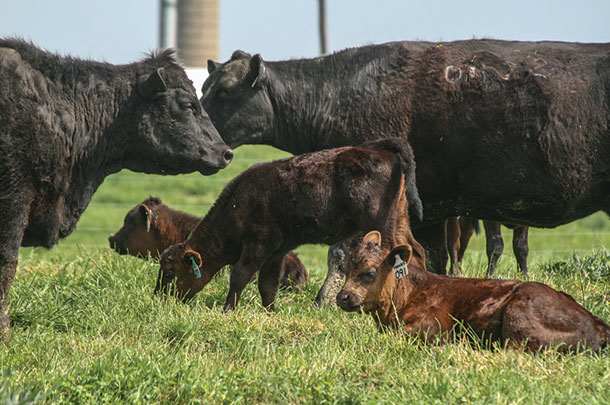 When it comes to dragging pastures, it either works for your operation’s goals or it doesn’t, and to make the decision even more challenging, the actual research on the effectiveness and the economics is limited to say the least.
When it comes to dragging pastures, it either works for your operation’s goals or it doesn’t, and to make the decision even more challenging, the actual research on the effectiveness and the economics is limited to say the least.
So if you’re looking at implementing this practice or if you are contemplating whether or not you should remove it from your management, one expert strongly encourages you to look at the benefits and determine if the benefits are worth the cost.
Benefit 1: Distribution of nutrients
Because manure is such an important fertilizer source, dragging pastures can help evenly disperse those nutrients throughout the pasture.
Benefit 2: Parasite control
Because parasites target fresh manure piles for laying their eggs, dragging or harrowing your pastures can open up the manure piles, killing the eggs from exposure to the sun.
Benefit 3: Winter feeding in a concentrated area
If you roll out your hay for winter feeding, it is suggested that you drag through the leftover hay piles to help distribute the manure as well as the leftover, stemmy roughage that wasn’t consumed.
Benefit 4: Distribution of seed
If there was seed in any hay fed during the winter, and you would like to assist in reseeding an area, dragging will help distribute the seed.
Learn more at: Dragging pastures: Are the benefits worth the cost?
6. The no-nos of nitrogen application in pastures
Published March 2016
Progressive Forage Editor Cassidy Woolsey
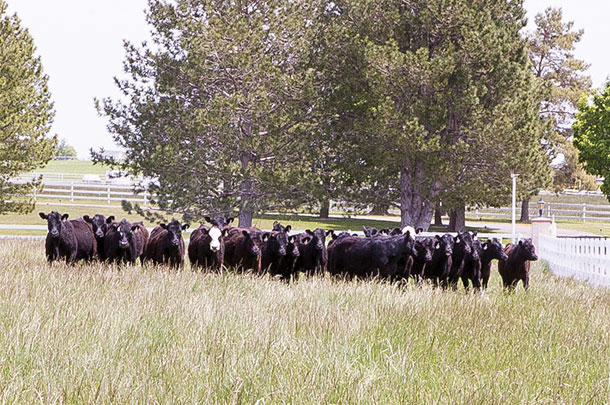 The number of times a parent says the word “no” in a day can feel almost endless. But as any parent or grown child knows, those “nos” are merely words of wisdom from someone who has, in a sense, “been there, done that.”
The number of times a parent says the word “no” in a day can feel almost endless. But as any parent or grown child knows, those “nos” are merely words of wisdom from someone who has, in a sense, “been there, done that.”
The same goes for industry experts, who have devoted their careers to studying and improving the livelihoods of producers across the country.
From someone who has “been there, done that” or “been there, seen that,” they have outlined a few things to avoid when it comes to nitrogen application in pastures.
- No-No 1: Applying more than 50 pounds of nitrogen per acre for any given application
- No-No 2: Applying nitrogen to pasture with greater than 30 percent legume concentration
- No-No 3: Applying nitrogen in the early spring or mid to late fall
- No-No 4: Applying nitrogen in pastures with heavy weed presence
- No-No 5: Applying nitrogen in a long-extended dry condition
Read it here: The no-nos of nitrogen application in pastures.
7. 300 days of grazing
Published July 2016
Melissa Beck, freelancer
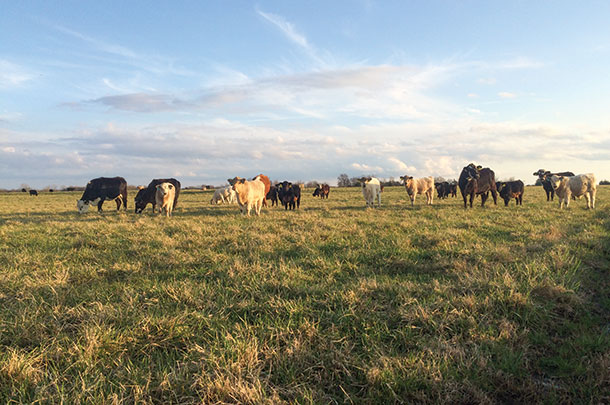 “It takes a change in mindset to make this happen,” says Jane Parish of Mississippi State University Extension, who implemented the 300 grazing days system to the university’s herd of 800-plus head.
“It takes a change in mindset to make this happen,” says Jane Parish of Mississippi State University Extension, who implemented the 300 grazing days system to the university’s herd of 800-plus head.
John Jennings, forage specialist with University of Arkansas, designed the program to reduce the reliance on stored hay.
Grasses may vary, or climates and soils may differ between regions, but the principles at the heart of the program are applicable to any situation. Roy Gene Britt, a cattleman from southwest Arkansas, test-piloted the program and discusses his results.
At the crux of the mindset change is shifting spending priorities from hay production to pasture production. And although it may be cheaper to have the cattle harvest the grass, that doesn’t mean it’s a cakewalk.
Parish walks producers through the steps of preparation and production to achieve 300 days of grazing.
Find the steps here: 300 days of grazing.
8. Predicting alfalfa forage quality with the PEAQ stick
Published March 2016
Glenn Shewmaker, University of Idaho forage specialist
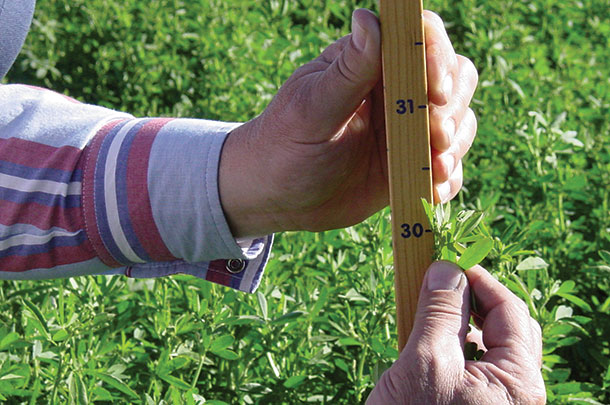 When your “hay man” comes in and says, “I just drove past the alfalfa field, and it’s ready to cut,” do you believe him? Can you predict the quality of your alfalfa by looking at it? Well, yes – and no.
When your “hay man” comes in and says, “I just drove past the alfalfa field, and it’s ready to cut,” do you believe him? Can you predict the quality of your alfalfa by looking at it? Well, yes – and no.
There is, however, an in-field method available to help determine quality. It’s called the PEAQ method (predictive equations for alfalfa quality).
Of all the quality factors a producer can control, maturity at cutting is the most important. That’s where the PEAQ stick comes in. By measuring the length of the longest stem in a sample and the growth stage of the most mature stem, a reasonable prediction of acid detergent fiber or relative forage value can be ascertained.
You don’t have to rely on someone eyeballing the field as they drive by anymore. And, perhaps best of all, the PEAQ stick will fit behind the pickup seat with all the other “important” things you have stashed back there.
Learn more at: Predicting alfalfa forage quality with the PEAQ stick.
9. Windrow moisture testing made easy
Published March 2016
Michael J. Thomas, freelancer and producer
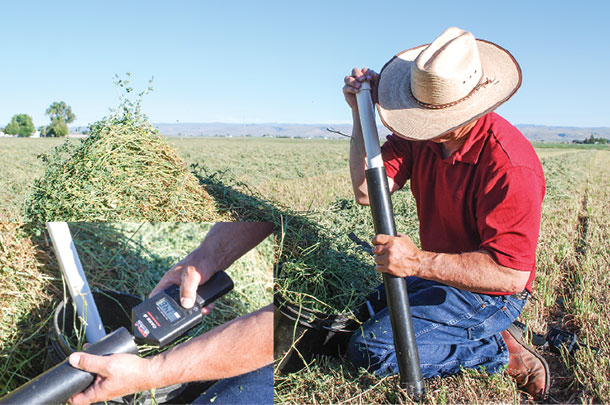 Always on the lookout for homemade tools that offer real value, readers appreciated University of Idaho forage specialist Glenn Shewmaker sharing the process of making and using a windrow moisture tester.
Always on the lookout for homemade tools that offer real value, readers appreciated University of Idaho forage specialist Glenn Shewmaker sharing the process of making and using a windrow moisture tester.
The key to quality alfalfa is leaf retention. Shewmaker says even with modern machinery designed to minimize leaf loss, proper moisture level is still the most effective means of ensuring leaf retention.
Today, producers are equipped with hand-held moisture testers, many large balers have high-quality on-board moisture testing equipment, and more producers are applying preservative to the hay to stretch the moisture window in order to maximize leaf retention and still maintain storage quality.
Despite all of these tools at our disposal, a producer is still faced with the dilemma of determining the stem moisture of the hay in the windrow across the entire field: too dry and you lose quality to leaf shatter, too wet and you cannot compensate with enough preservative or it becomes cost-prohibitive to apply enough to offset damage or fire.
Shewmaker walks readers through the construction and use of a simple PVC pipe moisture tester. And yes siree, this one will fit behind the pickup seat right along with the PEAQ stick.
Read how it works: Windrow moisture testing made easy.
10. Do you have one of these frequently-asked cover crop questions?
Published July 2016
Andrew Frankenfield, Penn State Extension educator
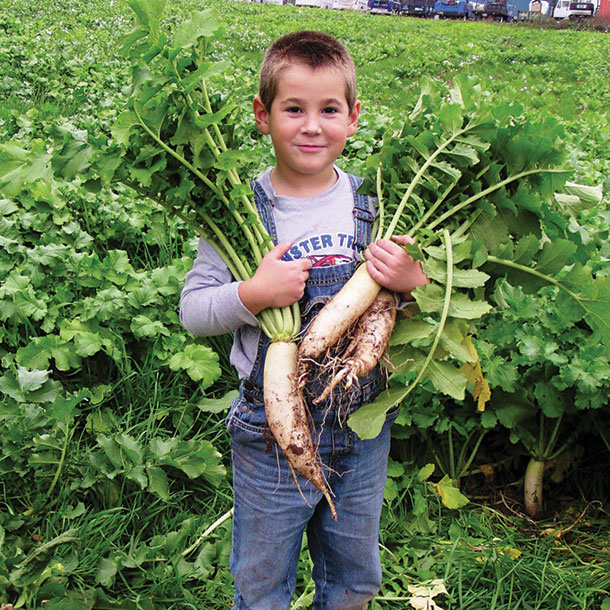 Cover crops continue to grow in popularity, and they continue to leave producers with as many questions as answers.
Cover crops continue to grow in popularity, and they continue to leave producers with as many questions as answers.
Extension educator Andrew Frankenfield takes common questions producers have and offers some help on practical issues like: when to plant, rate of seeding, how to set the drill for a seed mixture and what cover crop to choose. ![]()
Find the answers here: Do you have one of these frequently-asked cover crop questions?
PHOTO 1: Lisa Szymanski holds farm, home and family together in Port Austin, Michigan. She’s pictured here with her husband, Frank, and children, Luke, Faith and Grace. Photo provided by Frank Szymanski.
PHOTO 2: Austin (left) and Ray (right) have a tailgate meeting in the field. Photo provided by Beau Froese.
PHOTO 3: From left to right: Nathan, Velma, Len and Rod Riddle at one of their cornfields in Tuttle, Idaho. Photo by Staff.
PHOTO 4: LEFT: One bale unroller makes it possible for Andy Anderson, a 60-year-old rancher, to feed 400 cows by himself. RIGHT: This homemade bale unroller mounts to the front of a pickup using an old boat trailer axle. Photos by Andy Anderson.
PHOTO 5: Dragging pastures is one of those “it depends” practices. It may work agronomically – but not always economically. Photo by Staff.
PHOTO 6: If used correctly, nitrogen fertilizer can be used to improve pasture productivity and utilization throughout the grazing season. Photo by Staff.
PHOTO 7: A fall-calving herd grazes cool-season annuals in January at the Mississippi State University Prairie Unit. Photo provided by Dr. Jane Parish.
PHOTO 8: Using the PEAQ stick requires measuring the stem from the soil surface to the stem tip (not the tip of the highest leaf) on the correct side of the stick. Photo provided by Glenn Shewmaker.
PHOTO 9: ABOVE: Place the collection chamber on the ground with the capped end down and use the smaller tube (plunger) to compress the hay in the collection chamber. INSET: Record electronic moisture readings from four levels of the collection chamber and average the readings at 4-, 8-, 12- and 16-inch depths. Continue the process across the remainder of the field and average the data from all of the samples. Photos provided by Glenn Shewmaker.
PHOTO 10: Tanner Frankenfield displays radishes planted with cereal rye in late August. Photo provided by Andrew Frankenfield.
